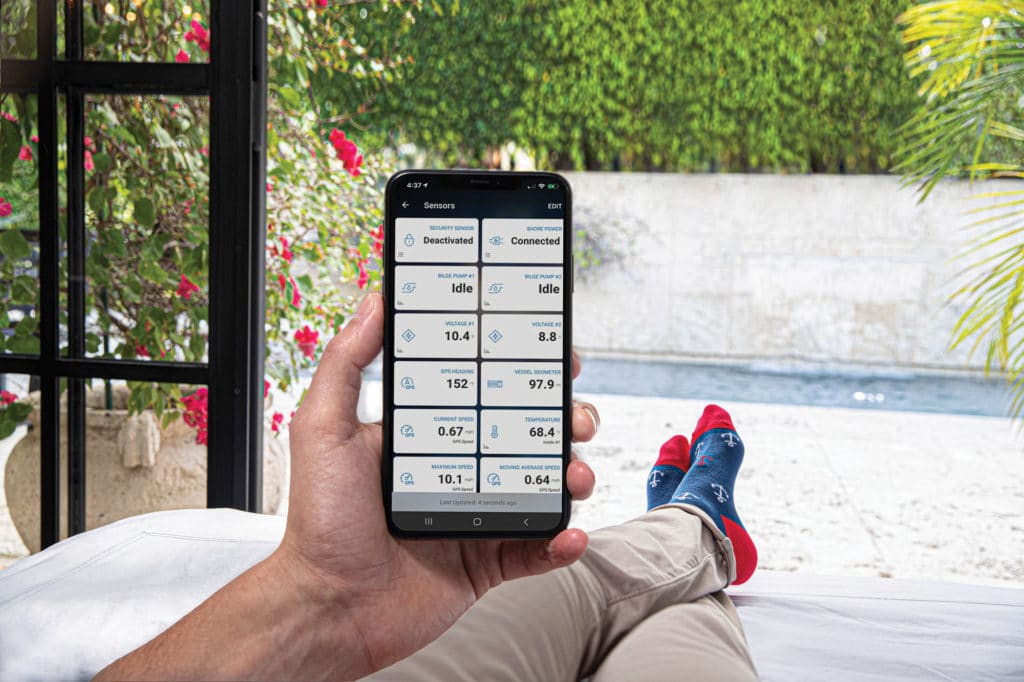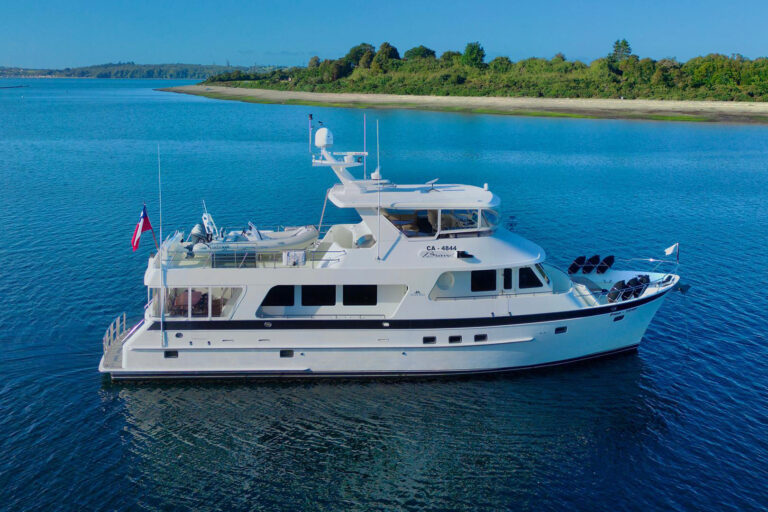
It’s a common story: Bluebird skies, calm seas and an A-list crew coalesce to create a perfect day on the water. Later, there’s an après celebration at the dock. Then, the longer-than-ideal drive home begins. The highway turns to the back roads as thoughts of Monday morning start encroaching, but the mood stays positive, buoyed by the day’s adventure.
That’s when the realization hits that the boat’s refrigeration system is still running. A U-turn unfurls, and an unexpected drive back to the boat ensues.
Monitoring, tracking and control systems are intended to change that story’s ending. These systems harness cellular (and sometimes satellite) connectivity to let owners keep an eye on their yachts. Some function like onboard security systems and immediately alert owners—typically via an email or text message—if a hatch or door has been opened, or if the yacht escapes its geofence. Other systems let owners monitor and control networked systems from afar.
Garmin’s OnDeck system delivers these standard features too, but the company’s product portfolio and long-term vision suggest that greater capabilities and increased integration may be on the horizon.
Garmin’s OnDeck system (from $850) consists of a GPS-enabled module and a function button on Garmin’s ActiveCaptain app, which can be run on a smartphone, tablet, personal computer or compatible multifunction display. OnDeck is NMEA 2000-friendly and comes with security, temperature and shore-power sensors, a 12-volt DC relay switch, a 19-pin data cable, a Garmin Marine Network cable, a power cable, an N2K drop cable and an N2K T-connector. Users can buy additional through-hull, temperature, shore-power and security sensors, as well as aftermarket LTE antennas.
OnDeck gives users the remote ability to view and control as many as five relay switches (more 12- and 24-volt DC relay switches can be added) via the ActiveCaptain app. For example, OnDeck owners can turn on or off their vessel’s cabin or courtesy lights, refrigerators, fans, ice makers, battery chargers and master power. They can also monitor bilge-pump activity and battery status. Users can set geofences that, if breached, trigger the system to alert the yacht’s owner. Likewise, the system can notify users if it senses problems (such as abnormal bilge-pump activity) or if there’s a shore-power issue.
All vessel data is sent via a cellular connection to Garmin’s cloud, where it’s stored for up to 30 days. Users need an airtime subscription to leverage their OnDeck system and access the cloud-stored data.
“Everyone expects the same creature comforts that they have at home or in their car on their boat,” says Dave Dunn, Garmin’s director of sales and marketing for marine. “OnDeck delivers peace of mind when they’re not there that all is OK.”
While mental serenity is always good, Dunn says OnDeck isn’t a security system. “There’s a 15-minute delay,” Dunn says, between when the system registers a door or hatch opening, or a vessel egressing its geofence, and when an owner receives notification. But this latency should shrink as 5G cellular networks are developed and integrated into the OnDeck ecosystem.
Satellite connectivity could also close the chronological gap between an onboard event and an owner receiving notification. While OnDeck doesn’t currently support satellite connectivity, Dunn says, it’s the system’s most frequently requested feature.
And this is where OnDeck’s potential becomes interesting.
In 2016, Garmin acquired DeLorme, which developed the InReach two-way satellite communicator. An InReach device allows users to send and receive text messages, share their location, and transmit interactive SOS alerts using Iridium’s global satellite-communications network. Since 2016, Garmin has innovated new InReach models and increased their functionality.
Since InReach devices already leverage satcom networks, it doesn’t take a psychic to see Garmin’s longer-term plans for OnDeck.
“On the surface, OnDeck seems like a me-too product,” Dunn says, “but we’re committed to giving customers the most innovative solution on the market.”
While Dunn remains mum about InReach integration, one can safely hypothesize that future iterations of OnDeck will include a built-in InReach antenna or the ability to network an external InReach device. This type of feature would give owners the ability to track their yacht, as well as monitor and control its onboard systems, irrespective of its proximity to a cellular network.
Integration with onboard digital-switching systems is also worth pondering. While the OnDeck system can currently control as many as five relay switches, integration with digital-switching systems would allow an owner to control every networked system or device. Because some Garmin equipment already integrates with third-party digital-switching systems (such as CZone), and because Garmin acquired EmpirBus (another digital-switching manufacturer) in early 2018, down-the-road integration can be expected.
Another safe assumption—given OnDeck’s N2K compatibility and its cellular modem, as well as the fact that some Garmin displays can already incorporate engine-manufacturer data—is that the system will become able to distribute service alerts or reminders.
Future capabilities aside, OnDeck’s N2K compatibility already delivers solid functionality. For example, OnDeck owners can stream real-time navigation data from their boat’s multifunction display to their ActiveCaptain app via Wi-Fi when they’re aboard. They also can keep tabs on things during captain-managed deliveries, so long as cellular connectivity exists.
Better still, Garmin’s OnDeck is label-agnostic. The rest of the helm “doesn’t need to be Garmin-built,” Dunn says. “It’s NMEA-certified, so it will work with anyone’s [N2K-certified] equipment.”
That said, Dunn adds that Garmin customers enjoy extra perks.
So, if you prefer the thought of savoring your post-boating glow without an unplanned return to the marina to turn off a piece of equipment, check out Garmin’s OnDeck system. Not only can it prevent vessel-management headaches today, but its capabilities should only improve as more devices and systems are integrated and as the technology matures.









